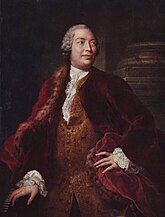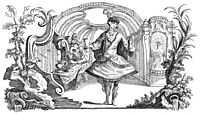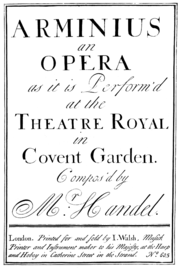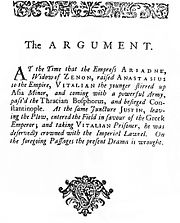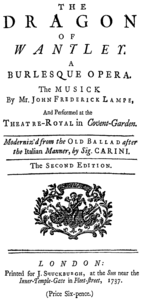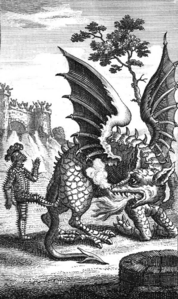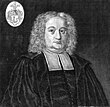Music year 1737
◄◄ | ◄ | 1733 | 1734 | 1735 | 1736 | Music year 1737 | 1738 | 1739 | 1740 | 1741 | ► | ►►
Overview of the music years
Further events
| Music year 1737 | |
|---|---|
| Antonio Stradivari, who is now considered by many to be the best violin maker in history, dies on December 18th in Cremona and is buried in the Basilica di San Domenico. He still practiced his craft in the year he died. |
Events
Johann Sebastian Bach
- Johann Sebastian Bach has been the Thomaskantor and musical director of the Thomaskirche in Leipzig since May 30, 1723 . In 1729 he also took over the management of the Collegium musicum founded by Georg Philipp Telemann in 1701 . Through the additional management of the college, he considerably expands his scope in Leipzig's musical life. With this student ensemble he performs German and Italian instrumental and vocal music, including his own concerts in Weimar and Köthen. The concerts take place once or twice a week in the Zimmermannisches Caffee-Hauß (destroyed in the war in 1943) or in the associated garden.
- September 28 : For the homage ceremony of the Electoral Saxon Councilor and Vice-Chamber President Johann Christian von Hennicke , who received the palace and Gut Wiederau near Leipzig as a hereditary fief in 1737 , Johann Sebastian Bach composed the cantata Angenehmes Wiederau (BWV 30a) based on a text by Johann Christian Henrici (Picander).
- Johann Sebastian Bach becomes a father for the nineteenth time. The twelfth child together with his second wife Anna Magdalena Bach , Johanna Carolina (1737–1781), is born.
- Bach examines the organ in the church of St. Peter and Paul in Weißensee , which was created by the organ builder CW Schäfer.
georg Friedrich Handel
- George Frideric Handel has lived in London at 25 Brook Street since July / August 1723 and lived here on two floors until his death in 1759. Almost all works created since 1723 are composed in this house. Preparations for the performances often take place in the Handel dining room .
- Handel, who founded the “second opera academy” together with Johann Jacob Heidegger in 1729 , has moved to the newly built Covent Garden Theater and is now running the opera company (the “third opera academy”) under his own direction and under his own financial responsibility.
- January 12th : The world premiere of the opera Arminio by Georg Friedrich Handel based on a presentation by Antonio Salvi takes place at the Covent Garden Theater in London. The leading roles are performed by Domenico Annibali , Anna Maria Strada , Gizziello and Francesca Bertolli . The work is not a success.
- February 16 : Georg Friedrich Handel's opera Giustino is premiered at the Covent Garden Theater with the same cast as Arminio . The literary model comes from Nicolò Beregan and Pietro Pariati .
- 23 March : The oratorio Il trionfo del Tempo e del Disinganno , the first version of which was composed by Georg Friedrich Handel in the spring of 1707 based on the libretto by Cardinal Benedetto Pamphili , is premiered in a revised version at the Theater Royal, Covent Garden in London. Handel will edit and perform the subject one more time in 1757 under the title The Triumph of Time and Truth .
- April: Handel suffers a stroke with symptoms of paralysis, but quickly recovers during a spa stay in the Aachen thermal springs in Burtscheid until September and composes with the old productivity.
- April 13 : The pasticcio Didone abbandonata by Georg Friedrich Händel is premiered at the Covent Garden Theater. It is an arrangement of the first opera libretto of the same name by Pietro Metastasio based on Leonardo Vinci's opera . Handel cannot direct the performance himself because of his stroke.
- May 18 : Berenice is the third opera by Georg Friedrich Handel within six months to be premiered at the Covent Garden Theater. The libretto is by Antonio Salvi. He cannot direct this world premiere either and, like all works of this season, it remains unsuccessful.
- End of May: Due to financial problems, Georg Friedrich Handel has to close his opera company and dissolve his opera company. But the rival Opera of the Nobility goes bankrupt and has to be dissolved. Significantly, another work by the more popular “light muse” is the company's “coffin nail”: the opera parody The Dragon of Wantley (libretto: Henry Carey ) by the German composer Johann Friedrich Lampe . This has a total of more performances than John Gays and Johann Christoph Pepusch's The Beggar's Opera at the time .
- Handel composed the Funeral Anthem ( The ways of Zion do mourn ) for Queen Caroline's state funeral .
Domenico Scarlatti
- Domenico Scarlatti is the Portuguese princess Maria Bárbara de Bragança , whom he met at the court of the pious and extravagant King John V in Lisbon and taught as a music teacher, after her marriage to the Spanish heir to the throne Don Fernando of Asturias (from 1746 King Ferdinand VI. ) followed to Spain. From October 1730 to May 16, 1733, the Alcázares Reales in Seville was his permanent residence and place of work. Then the farm moves north to the area around Madrid , where, depending on the season, it alternates between the castles of Buen Retiro , El Pardo , Aranjuez , La Granja and El Escorial . Scarlatti is probably still in the "private" service of Maria Bárbara and seems to devote himself almost exclusively to the harpsichord and the composition of his sonatas.
Georg Philipp Telemann
- Georg Philipp Telemann has been Cantor Johannei and Director Musices of the city of Hamburg since 1721 , one of the most respected musical offices in Germany. In this position Telemann undertook to compose two cantatas per week and one passion per year, but in later years he would fall back on earlier works for his cantatas. He also composes numerous pieces of music for private and public occasions, such as memorial days and weddings.
- In addition, Telemann has taken over the management of the Hamburg Opera at Gänsemarkt for an annual salary of 300 thalers , rebuilds the Collegium musicum, which was founded by Matthias Weckmann in 1660 but has since ceased to perform, and also takes on a position as Kapellmeister for the court Margraves of Bayreuth . From time to time he delivers instrumental music and an opera there every year.
- Following a long-cherished wish, Telemann visited Paris in autumn 1737 after being invited by a group of musicians there ( Jean-Baptiste-Antoine Forqueray , Jean-Pierre Guignon and Michel Blavet ). During his absence, Telemann was represented by Johann Adolf Scheibe . Seven of Telemann's works are already reprinted in Paris. After a four-month stay, the French king grants him an exclusive right to his publications for 20 years, which is intended to protect against pirated prints . With several performances of his works Telemann finally achieved international fame. He is the first German composer to introduce himself at the Concert Spirituel , which gives public concerts. Telemann's Nouveaux Quatuors (“Paris Quartet”, 1737) are among Telemann's most popular instrumental works today. In May 1738 Telemann, whose reputation was also increased in Germany by the trip, returned to Hamburg.
Antonio Vivaldi
- Antonio Vivaldi has been musical director of the Teatro Sant'Angelo in his hometown of Venice since 1726 . There, both as a composer and as a violin virtuoso, he became a living legend and a “pilgrimage destination” for many musicians from all over Europe.
- February 5th : World premiere of the opera Il giorno felice by Antonio Vivaldi based on a libretto by Francesco Scipione Maffei in the Kärntnertortheater in Vienna .
- May: At the Teatro Filarmonico di Verona is Antonio Vivaldi's opera Catone in Utica on the libretto by Pietro Metastasio premiered.
Other biographical events
- Giovanni Battista Bononcini loses a lot of money in dubious speculations and temporarily has to earn his living as a copyist .
- William Boyce directs the Three Choirs Festival .
- Riccardo Broschi is engaged at the court of Carl Alexander von Württemberg in Stuttgart as a “compositore di musica”. His opera Adriano in Siria , which had its first performance in Milan in 1735, is performed here in early 1737 . The Duke's sudden death on March 12, 1737 ended his stay in Stuttgart prematurely.
- After spending three years in England, Farinelli traveled to Spain in 1737. On the way he spends a few months in France , where he was before Louis XV. sings. In Spain, which he had originally only wanted to visit for five months, he finally stayed for almost twenty-five years (1737–1759). His singing is used by Queen Elisabetta Farnese to cure Philip V's severe depression , just as the castrato singer Matteuccio had done for Charles II 40 years earlier . For nine years (until Philip's death in 1746) he was only allowed to sing for the king - according to a letter from Farinelli dated February 15, 1738 to his friend Count Pepoli, he had to "perform eight or nine arias every evening".
- Giovanni Battista Ferrandini , who had already been given a position as oboist in the court orchestra in Munich as a boy and rose to chamber composer in 1732, becomes director of chamber music.
- Geminiano Giacomelli , who has returned to Parma and resumed his two positions at court and at the Madonna della Steccata church by 1737, went to Graz in 1737, where he directed the performances of his opera Cesare in Egitto .
- Charles-Joseph van Helmont becomes cantor at the court church Notre-Dame-de-la-Chapelle ( "Kapellekerk" ) of the governor of the Netherlands, Archduchess Maria Elisabeth . He will hold this position until her death in 1741.
- Ignaz Holzbauer , who works as Kapellmeister in Holleschau , married the opera singer Rosalie Andreides († 1785) from Olomouc on April 30th at his place of employment .
- Together with Henry Carey, Johann Friedrich Lampe is writing by far his most successful work, the opera parody The Dragon of Wantley , which has more contemporary performances than Gays Beggar’s Opera . The sequel, Margery, or A Worse Plague than the Dragon, in 1738 will be less successful.
- Benedetto Marcello , who had been sent as Provveditore (Governor) of the Republic of Venice in Pola in Istria in today's Croatia since 1730 , is returning to Venice due to his poor health .
- After the death of his predecessor Francesco Mancini, Domenico Sarro is appointed court conductor at the court of Naples. One of his first tasks is to compose the opera for the official opening of the Teatro San Carlo , Achille in Sciro .
- From 1737 to 1740 Johann Adolf Scheibe published Der critische Musicus, a journal that dealt with issues of musical aesthetics that were important at the time.
Quotes
“I have heard this great man play different times. One is astonished at his skill, and one can hardly understand how it is possible that he can put his fingers and feet so neatly and so nimbly into one another, stretch them and thus make the farthest jumps without mixing in a single wrong note or through one such violent movement to adjust the body. "
“This great man would be the admiration of whole nations if he had more comfort and if he did not withdraw the natural from his pieces with a pompous and confused being and obscure their beauty with too great art. Because he judges by his fingers, his pieces are extremely difficult to play; for he demands the singers and instrumentalists should do with their throats and instruments what he can play on the piano. But this is impossible. [...] one admires [...] the arduous work and an extraordinary effort, which is applied in vain because it fights against reason. "
Openings
- November 4th : The Teatro San Carlo opens on the name day of King Charles VII of Naples with the performance of Domenico Sarros Achille in Sciro based on the libretto by Pietro Metastasio . Domenico Sarro conducts his own work on this occasion. The Teatro San Carlo was designed and built for the Bourbon king from 1735 by the architects Giovanni Antonio Medrano and Angelo Carasale . The king wants to equip Naples with a new and larger theater in place of the old decaying Teatro San Bartolomeo from 1621. The Teatro di San Carlo will for years be the largest opera house with 3,300 seats and, even before the La Scala in Milan , the most prestigious house in Europe and the world, and will be admired for its architecture and rich furnishings alone.
World premieres
Stage works
Opera
- January 12th : The world premiere of the opera Arminio by Georg Friedrich Handel based on a presentation by Antonio Salvi takes place at the Covent Garden Theater in London. The leading roles are performed by Domenico Annibali , Anna Maria Strada , Gizziello and Francesca Bertolli . The work is not a success.
- February 5th : World premiere of the opera Il giorno felice by Antonio Vivaldi based on a libretto by Francesco Scipione Maffei in the Kärntnertortheater in Vienna .
- February 6 : The world premiere of the tragic comedy Alessandro in Sidone by Giovanni Bononcini takes place at the Kleiner Hoftheater in Vienna.
- February 16 : Georg Friedrich Handel's opera Giustino is premiered at the Covent Garden Theater with the same cast as Arminio . The literary model comes from Nicolò Beregan and Pietro Pariati .
- Carnival: The Dramma per musica in three acts Demetrio by Geminiano Giacomelli based on the libretto by Pietro Metastasio will be premiered at the Teatro Regio in Turin .
- April 13 : The pasticcio Didone abbandonata by Georg Friedrich Händel is premiered at the Covent Garden Theater. It is an arrangement of the first opera libretto of the same name by Pietro Metastasio based on Leonardo Vinci's opera . Handel cannot direct the performance himself because he had recently suffered a stroke.
- May 11 : The Teatro Malvezzi in Bologna opera is Siface of Leonardo Leo premiered.
- May 16 : The burlesque opera The Dragon of Wantley by John Frederick Lampe based on the libretto by Henry Carey premieres at the Little Theater in the Haymarket in London.
-
- May 18 : Berenice is the third opera by Georg Friedrich Handel within six months to be premiered at the Covent Garden Theater. He cannot direct this world premiere either and, like all works of this season, it remains unsuccessful.
- May: At the Teatro Filarmonico di Verona is Antonio Vivaldi's opera Catone in Utica on the libretto by Pietro Metastasio premiered.
- August 3: The opera Asteria by Johann Adolph Hasse has its world premiere in the Opera House at the Zwinger in Dresden.
- August 28 : Giovanni Bononcini's setting of Pietro Metastasio's libretto Zenobia has its world premiere to celebrate the birthday of Empress Elisabeth at the Favorita in Vienna.
- October 12th : The musical drama Lucio Papirio by Ignaz Holzbauer based on the libretto by Apostolo Zeno is premiered in Holleschau .
- October 24 : Jean-Philippe Rameau's third opera Castor et Pollux based on a libretto by Pierre-Joseph-Justin Bernard is premiered at the Académie Royale de Musique in Paris. The work is a complete success and heats up the dispute between the supporters of Rameau and the conservative advocates of Jean-Baptiste Lully's music .
- October 31 : In Vyškov , the opera Adriano in Siria by Johann Adolph Hasse on the libretto by Pietro Metastasio is premiered.
- November 4 : The Teatro San Carlo , at the time the largest opera house in Europe, opens in Naples with the performance of Domenico Sarro's setting of Pietro Metastasio's Achille in Sciro . The composer conducts the work himself on this occasion.
- December 19 : The opera L'olimpiade by Leonardo Leo based on a libretto by Pietro Metastasio is performed for the first time at the Teatro San Carlo in Naples .
- Domenico Alberti - Serenata Endimione (libretto by Pietro Metastasio ; world premiere in Venice )
-
Nicola Antonio Porpora
- Lucio Papirio (Dramma per musica in three acts; libretto by Antonio Salvi and Domenico Lalli ; world premiere in Venice)
- Rosbale ("Dramma per musica" in three acts; libretto by Domenico Lalli ; world premiere in Venice)
- Marriage of Statira, Queen of Persia (pasticcio; libretto by Roberto Girolamo Frigimelica and Christoph Gottlieb Wend ; world premiere in Hamburg)
Oratorio
- 23 March : The oratorio Il trionfo del Tempo e del Disinganno , the first version of which was composed by Georg Friedrich Handel in the spring of 1707 based on the libretto by Cardinal Benedetto Pamphili , is premiered in a revised version at the Theater Royal, Covent Garden in London.
- Giovanni Battista Bononcini - Ezechia (world premiere in Vienna)
- Francesco Feo (with Domenico Sarro ) - Gesà adorato dai tre magi (world premiere in Genoa)
- Jean-Joseph Fiocco - Il transito di San Giuseppe
- Johann Adolph Hasse - Le Virtù appié della Croce (libretto by Stefano Pallavicini ; world premiere in Dresden)
- Nicola Antonio Porpora - Gedeone (world premiere in Vienna)
- Gottfried Heinrich Stölzel - Christmas Oratorio (ten-part cantata cycle; first performance between Christmas 1736 and Epiphany 1737)
- Georg Philipp Telemann - Jesus, your holy wounds (TWV 5:22)
Instrumental music
Concerts
- Christoph Graupner - Concerto for Chalumeau, bassoon and violoncello in C major (GWV 306)
Chamber music
- Joseph Bodin de Boismortier - Petites Sonates suivies d'une Chaconne pour deux Bassons, Violonceles ou Violes , Op. 66
- Nicolas Chédeville - Il pastor fido, sonates ... del sigr Antonio Vivaldi by Chédeville for Musette de Cour (hurdy-gurdy, transverse flute, oboe or violin)
- Pietro Locatelli - XII Sonata à Violino solo è Basso da Camera, Op. 6 (Amsterdam)
- Georg Philipp Telemann - Nouveaux Quatuors ("Paris Quartet")
flute
- Giovanni Battista Ferrandini - 6 Sonatas, Op. 2
viola
- Charles Dollé - Pieces de viole , Op. 2
violin
-
Jean-Marie Leclair
- 6 concertos a tre violini, alto e basso, per organo e violoncello , Op. 7th
- Deuxième Récréation de musique d'une exécution facile composée pour deux flûtes ou deux violons , Op. 8 (Paris)
violoncello
- Leonardo Leo - 6 cello concertos (1737–1738)
Keyboard music
harpsichord
- Charles-Joseph van Helmont - Pièces de Clavecin , Op. 1
organ
- Michel Corrette - Premier Livre d'Orgue , Op. 16
Vocal music
Spiritually
- Johann Sebastian Bach - Motet O Jesus Christ, the light of my life (BWV 118)
- Georg Friedrich Händel - Funeral Anthem ( The ways of Zion do mourn , HWV 264)
- Gottfried Heinrich Stölzel - Glory to God on high (H. 342)
-
Jan Dismas Zelenka
- Requiem (ZWV 45)
- 6 Ave Regina Coelorum (ZWV 128)
Worldly
- Johann Sebastian Bach - Cantata Angenehmes Wiederau (BWV 30a)
- Valentin Rathgeber - ear vergnügendes and mind-ergötzendes panel Confect, also Augsburger panel Confect called
- Jan Dismas Zelenka - Serenata Il diamante (ZWV 177)
Popular music
- Henry Carey - Ballad Sally in Our Alley
Textbooks
- Carl Johann Friedrich Haltmeier - Instructions for transposing
- Jacques Hotteterre - Method for the Musette , Op. 10
- David Kellner - Faithful lessons in general bass
- Johann Friedrich Lampe - A Plain and Compendious Method of Teaching Thorough Bass
- Johann Mattheson - the core of melodic science, consisting of the most exquisite main and basic lessons of the musical art of composition or composition
- Jean-Philippe Rameau - Génération harmonique, ou Traité de musique théorique et pratique (Paris)
- Johann Adolf Scheibe - The Critical Musicus
Instrument making
-
Gottfried Silbermann
- completes the organ in the Friedenskirche (village church) in Ponitz after three years of construction .
-
Antonio Stradivarius
- makes the violins Comte d'Amaille , Lord Norton and " Chant du Cygne - Swan Song ".
Born
- January 3 : Heinrich Wilhelm von Gerstenberg , German poet, librettist and critic († 1823 )
- March 9 : Josef Mysliveček , Bohemian composer († 1781 )
- March 27 : Francesco Zannetti , Italian composer († 1788 )
- April 10 : François Giroust , French composer († 1799 )
- September 14 : Michael Haydn , Austrian composer († 1806 )
- November 25 : Christian Friedrich Penzel , German cantor and composer († 1801 )
Died
- February 12 : Benjamin Schmolck , Silesian hymn poet (* 1672 )
- March 7th : Francesco Antonio Tullio , Italian librettist (* 1660 )
- April 2 : Antonio Montanari , Italian composer and violinist (* 1676 )
- April 12 : Johann Sigismund Weiss , German composer and lutenist (* after 1690 )
- April 25 : Rupert Pfärtl , Bavarian Benedictine priest and choir director (* 1704 )
- June 18 : Johan Niclas Cahman , Swedish organ builder (* around 1670 )
- July 6th : Pietro Torri , Italian composer (* around 1650 )
- August 10 : Antonio Cristofori , Italian painter and musician (* 1701 )
- September 22nd : Francesco Mancini , Neapolitan conductor and composer (* 1672 )
- September 22nd : Michel Pignolet de Montéclair , French composer (* 1667 )
- December 18 : Antonio Stradivari , Italian master violin maker (* around 1644 )
Exact date of death unknown
- David Petersen , German violinist and composer (* around 1650 )
Died around 1737
- Enoch Blinzig , German composer and conductor (* around 1661 )


